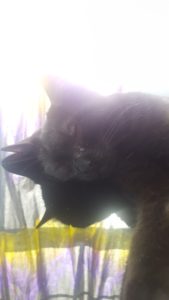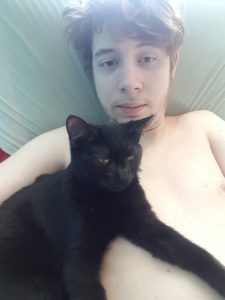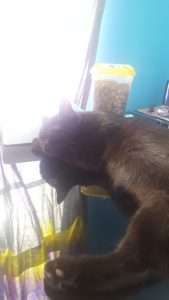Family Feature: Giving an Animal Hoarding Survivor a Second Chance at Life

Adopting a new pet can be planned or spontaneous. Recently, a family I have known for many years was bitten by the love bug when they saw a kitten up for adoption. With golden eyes and beautiful black fur, it is easy to see why the Grimm family found the little kitty so irresistible. But Ten-Ten, formerly known as Sparkles, didn’t have an easy start to life. Ten-Ten was found with 21 other cats in a hoarding situation in West Virginia. The six-month old kitten was found in a bad condition and needed eye surgery that would leave
her blind in one eye. But did that stop the Grimm’s from adopting Ten-Ten? Not at all!
 Animal hoarding situations are a heartbreaking mixture of mental illness and usually unintentional animal abuse. Hoarders usually feel as if though they are saving animals when in reality they are subjecting them to subpar sanitary conditions, veterinary care, possible disease, malnourishment, and a lack of love and attention. The hoarders themselves are also subjecting themselves to a life of heartbreak because of their possible unresolved attachment disorders and lack of sanitary living conditions.
Animal hoarding situations are a heartbreaking mixture of mental illness and usually unintentional animal abuse. Hoarders usually feel as if though they are saving animals when in reality they are subjecting them to subpar sanitary conditions, veterinary care, possible disease, malnourishment, and a lack of love and attention. The hoarders themselves are also subjecting themselves to a life of heartbreak because of their possible unresolved attachment disorders and lack of sanitary living conditions.
Having too many animals to take care of not only takes a mental and physical toll on the animals, but also their owners. While it may be easy to point fingers and lay blame, we need to keep in mind that many hoarders don’t think they are hurting their animals and need just as much help and support as their animals do.
In an interview with Shelly Grimm, the matriarch of the Grimm family, I found out how Ten-Ten is doing in her long journey to recovery.
Shelly and her family are not new to having a fur-baby. They have a thirteen-year-old dog named Ki LaLa and have adopted other cats before Ten-Ten. Shelly told me that Ten-Ten, however, is “unlike any cat she has had before” and that “Ten-Ten wags her tail like a dog and loves to cuddle.”
I asked Shelly how Ten-Ten gets along with their senior dog. She said that “she is not a fan of the dog as of right now” but she thinks that they will get along better after she has more time to adjust. Upon arrival to her new forever home, Ten-Ten hid underneath Shelly’s son Zach’s couch. Shelly told me when asked about the family’s new kitty’s adjustment to her home that “Zach has been the primary care taker” and that Ten-Ten took a shining to Zach pretty fast. The little kitty was slowly introduced more and more to the whole family. They took turns visiting Ten-Ten as she hid underneath the couch and she slowly warmed up to everyone.
After many visits from Shelly and her other sons, Ten-Ten can’t get enough of her new family. Shelly says that “Ten-Ten has become more sociable” and this is most likely due to the low stress environment in their home. Ten-Ten, before living with her adoptive family, had it rough, competing for resources and love, but with the Grimms, there is love to spare.
Ten-Ten is a very lucky kitty. She made it out of a rough situation and was adopted by a kind, caring family who wants to give her all of the love and attention Ten-Ten can handle. Unfortunately, not all animals in hoarding situations make it. Ten-Ten may have had to have surgery, but otherwise she was healthy. Competing for food, living in filthy, over-crowded environments, and not having any proper veterinary care is what happens to animals who are in hoarding situations. Shelly told me that “Ten-Ten eats a lot” and that is most likely because she lived among 21 other cats and had limited access to food and fresh water.
The animal rescue team who found Ten-Ten and the Grimm family gave this kitty another chance at life. At six-months old, she has seen quite a lot of heartbreak and devastation. However, with the Grimm family caring for her, the rest of her days will be filled with cuddles, kisses, toys, and lots of delicious food. Ten-Ten was given a new lease on life. If you would like to learn more about you can do to help, visit our page 7 Ways to Help out in a Hoarding Situation.


